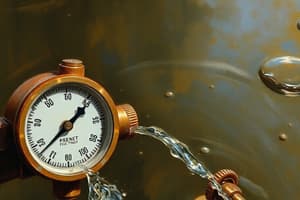Podcast
Questions and Answers
What is the primary formula for calculating pressure?
What is the primary formula for calculating pressure?
- Pressure = Mass / Volume
- Pressure = Density × Area
- Pressure = Weight / Height
- Pressure = Force / Area (correct)
Pressure increases with depth in a static fluid.
Pressure increases with depth in a static fluid.
True (A)
What is the standard atmospheric pressure in Pascals?
What is the standard atmospheric pressure in Pascals?
101325
Gauge pressure is the difference between absolute pressure and __________ pressure.
Gauge pressure is the difference between absolute pressure and __________ pressure.
What happens to atmospheric pressure as altitude increases?
What happens to atmospheric pressure as altitude increases?
Match the following types of pressure with their definitions:
Match the following types of pressure with their definitions:
An object will float if its density is greater than the density of the fluid surrounding it.
An object will float if its density is greater than the density of the fluid surrounding it.
What principle explains why objects float or sink in a fluid?
What principle explains why objects float or sink in a fluid?
Flashcards
What is pressure?
What is pressure?
Force applied over a specific area. Measured in Pascals (Pa) or pounds per square inch (psi), it's essential in various fields like fluid mechanics and materials science.
How does pressure work in fluids?
How does pressure work in fluids?
Fluids, whether liquids or gases, apply pressure in all directions. This pressure increases with depth. The pressure at a specific depth is the same in all directions.
What is atmospheric pressure?
What is atmospheric pressure?
Pressure exerted by the Earth's atmosphere. It decreases with increasing altitude, and standard atmospheric pressure is about 101,325 Pa or 1 atmosphere.
What is gauge pressure?
What is gauge pressure?
Signup and view all the flashcards
What is absolute pressure?
What is absolute pressure?
Signup and view all the flashcards
What is buoyancy?
What is buoyancy?
Signup and view all the flashcards
What are hydraulic systems?
What are hydraulic systems?
Signup and view all the flashcards
How is pressure important in applications?
How is pressure important in applications?
Signup and view all the flashcards
Study Notes
Introduction to Pressure
- Pressure is a scalar quantity defined as force per unit area.
- The formula for pressure is Pressure = Force / Area.
- Pressure units include Pascals (Pa), Newtons per square meter (N/m²), pounds per square inch (psi), and atmospheres (atm).
- Pressure is crucial in fluid mechanics, thermodynamics, and materials science.
Pressure in Fluids
- Fluids (liquids and gases) exert pressure in all directions.
- Pressure in a static fluid increases with depth.
- Pressure at a given depth is the same in all directions (Pascal's Law).
- Pressure exerted by a fluid at a given depth is proportional to the fluid's density and the depth. Pressure = Density × Gravity × Depth.
Atmospheric Pressure
- Atmospheric pressure is the pressure exerted by Earth's atmosphere.
- Atmospheric pressure decreases with increasing altitude.
- Standard atmospheric pressure is approximately 101,325 Pa or 1 atmosphere.
- Barometers measure atmospheric pressure.
- Variations in atmospheric pressure are crucial in weather forecasting.
Gauge Pressure vs. Absolute Pressure
- Gauge pressure is the difference between absolute pressure and atmospheric pressure.
- Absolute pressure includes atmospheric pressure.
- Gauge pressure is often used in engineering for pressure gauge readings.
Pressure and Buoyancy
- Buoyancy is the upward force on an object in a fluid.
- Archimedes' principle: Buoyant force equals the weight of the displaced fluid.
- An object floats if buoyant force is greater than its weight (density less than fluid); otherwise, it sinks.
Applications of Pressure
- Pressure powers hydraulic systems, transmitting forces using pressurized fluids.
- Pressure is vital in designing machinery like airplane wings, dams, and pipelines.
- High pressures are used in industrial processes (manufacturing, construction).
Measuring Pressure
- Instruments to measure pressure include: Bourdon gauges, manometers, mercury barometers, and digital pressure sensors.
- Instrument selection depends on the application and pressure range.
Studying That Suits You
Use AI to generate personalized quizzes and flashcards to suit your learning preferences.



